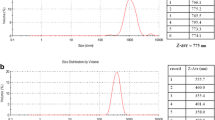Abstract
In the present study polymeric microbeads of poly(2-hydroxyethyl methacrylate-co-dodecyl methacrylate-co-acrylic acid) or p(HEMA-co-dDMA-co-AA) were synthesised and characterized through FT-IR and scanning electron microscopy (SEM); their swelling behavior against saline solution was explored and their in vitro cytotoxicity was evaluated. Further, in order to elucidate kinetic aspects regarding the ternary system p(HEMA-co-dDMA-co-AA), a mathematical model of the reactivity ratios of the comonomers in the terpolymer has been conceived and analyzed. An intensified tendency of AA units accumulation in the copolymer has been noticed, in spite of HEMA units, while dDMA conserves in the copolymer the fraction from the feed. Three compositions have been selected for nafcillin-loading and their in vitro release capacity was evaluated. The compositions of 80:10:10 and 75:10:15 M ratios appear suitable for further in vivo testing, in order to be used as drug delivery systems in the treatment of different osseous diseases.








Similar content being viewed by others
References
Brannon-Peppas L. Recent advances on the use of biodegradable microparticles and nanoparticles in controlled drug delivery. Int J Pharm. 1995;116:1–9.
De Wit M, Raabe A, Tuinmann G, Hossfeld DK. Implantable device for intravenous drug delivery in the rat. Lab Anim. 2001;35:321–4.
Branco MC, Schneider JP. Self-assembling materials for therapeutic delivery. Acta Biomater. 2009;5:817–31.
Kim S, Kim J-H, Jeon O, Kwon IC, Park K. Engineered polymers for advanced drug delivery. Eur J Pharm Biopharm. 2009;71:420–30.
Elvira C, Gallardo A, San Roman J, Cifuentes A. Covalent polymer-drug conjugates. Molecules. 2005;10:114–25.
Rezwan K, Chen QZ, Blaker JJ, Boccaccini AR. Biodegradable and bioactive porous polymer/inorganic composite scaffolds for bone tissue engineering. Biomaterials. 2006;27:3413–31.
Nair LS, Laurencin CT. Polymers as biomaterials for tissue engineering and controlled drug delivery. Adv Biochem Eng/Biotechnol. 2006;102:47–90.
Ringsdorf H. Structure and properties of pharmacologically active polymers. J Polym Sci Polym Symp. 1975;51:135–53.
Norden CW, Bryant R, Palmer D, Montgomerie JZ, Wheat J. Chronic osteomyelitis caused by Staphylococcus aureus: controlled clinical trial of nafcillin therapy and nafcillin-rifampin therapy. South Med J. 1986;79:947–51.
Pillai RR, Somayaji SN, Rabinovich M, Hudson MC, Gonsalves KE. Nafcillin-loaded PLGA nanoparticles for treatment of osteomyelitis. Biomed Mater. 2008;3:034114.
Lacey RW, Stokes A. Susceptibility of the “penicillinase-resistant” penicillins and cephalosporins to penicillinase of Staphylococcus aureus. J Clin Pathol. 1977;30:35–9.
Sato K, Lin TY, Weintrub L. Bacteriological efficacy of nafcillin and vancomycin alone or combined with rifampicin or amikacin in experimental meningitis due to methicillin-susceptible or -resistant Staphylococcus aureus. Jpn J Antibiotics. 1985;38:2155–62.
Katime I, Sáez V, Hernáez E. Nafcillin release from poly(acrylic acid–co–methyl methacrylate) hydrogels. Polym Bull. 2005;55:403–9.
Chan V. Influence of temperature and drug concentration on nafcillin precipitation [1]. Am J Health-System Pharm. 2005;62:1347–8.
Katime I, Valderruten N, Quintana JR. Controlled release of aminophylline from poly(N-isopropylacrylamide-co-itaconic acid) hydrogels. Polym Int. 2001;50:869–79.
Duncan R. Drug-polymer conjugates: potential for improved chemotherapy. Anti-Cancer Drugs. 1992;3:175–210.
Duncan R. Polymer conjugates for tumour targeting and intracytoplasmic delivery. The EPR effect as a common gateway? Pharm Sci Technol Today. 1999;2:441–9.
Putman D, Kopecek J. Polymer conjugates with anticancer activity. Adv Polym Sci. 1995;122:55–123.
Mabilleau G, Stancu IC, Honore T, Legeay G, Cincu C, Basle MF, Chappard D. Effects of the length of crosslink chain on poly(2-hydroxyethyl methacrylate) (pHEMA) swelling and biomechanical properties. J Biomed Mater Res A. 2006;77:35–42.
Sharma S, Nijdam AJ, Sinha PM, Walczak RJ, Liu X, Cheng MM-C, Ferrari M. Controlled-release microchips. Expert Opin Drug Deliv. 2006;3:379–94.
Wu P, Grainger DW. Drug/device combinations for local drug therapies and infection prophylaxis. Biomaterials. 2006;27:2450–67.
Merz E, Alfrey T, Goldfinger G. Intramolecular reactions in vinyl polymers as a means of investigation of the propagation step. J Polym Sci A. 1996;34:5–12.
Babazadeh M. Synthesis, characterization, and in vitro drug-release properties of 2-hydroxyethyl methacrylate copolymers. J Appl Polym Sci. 2007;104:2403–9.
Zecheru T, Filmon R, Rusen E, Marculescu B, Zerroukhi A, Cincu C, Chappard D. Biomimetic potential of some methacrylate-based copolymers: a comparative study. Biopolymers. 2009;91:966–73.
Mayo FR, Lewis FM. Copolymerization I. A basis for comparing the behavior of monomers in copolymerization; the copolymerization of styrene and methyl methacrylate. J Am Chem Soc. 1944;66:1594–601.
Hagiopol C. Copolymerization: toward a systematic approach. New York: Kluwer-Academic/Plenum; 1999.
Berger M, Kuntz I. The distinction between terminal and penultimate copolymerization models. J Polym Sci A. 1964;2:1687–98.
Ito K, Uchida K, Kitano T, Yamada E, Matsumoto T. Solvent effects in radical copolymerization between hydrophilic and hydrophobic monomers; 2-hydroxyethyl methacrylate and lauryl methacrylate. Polym J. 1985;17:761–6.
Denizli A, Garipcan B, Karabakan A, Senöz H. Synthesis and characterization of poly(hydroxyethyl methacrylate-N-methacryloyl-(l)-glutamic acid) copolymer beads for removal of lead ions. Mater Sci Eng C. 2005;25:448–54.
Arifin DY, Lee LY, Wang C-H. Mathematical modeling and simulation of drug release from microspheres: implications to drug delivery systems. Adv Drug Deliv Rev. 2006;58:1274–325.
Serra L, Doménech J, Peppas NA. Drug transport mechanisms and release kinetics from molecularly designed poly(acrylic acid-g-ethylene glycol) hydrogels. Biomaterials. 2006;27:5440–51.
Mackerle J. Finite-element analysis and simulation of polymers: a bibliography (1976–1996). Model Simul Mater Sci Eng. 1997;5:615–50.
Acknowledgments
Professor Georgios Staikos from University of Patras is gratefully acknowledged for his kind support with the elemental analysis. The project PN II IDEAS 729/2009 Polymer biomaterials for bone regeneration. Biomimetism through surface nanostructing is gratefully acknowledged.
Author information
Authors and Affiliations
Corresponding author
Rights and permissions
About this article
Cite this article
Zecheru, T., Rotariu, T., Rusen, E. et al. Poly(2-hydroxyethyl methacrylate-co-dodecyl methacrylate-co-acrylic acid): synthesis, physico-chemical characterisation and nafcillin carrier. J Mater Sci: Mater Med 21, 2793–2804 (2010). https://doi.org/10.1007/s10856-010-4129-y
Received:
Accepted:
Published:
Issue Date:
DOI: https://doi.org/10.1007/s10856-010-4129-y




